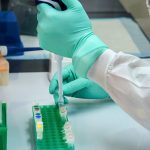How do plants sense and acquire nitrate?
ASPB Conviron Scholars Independent Project
Nitrogen (N) is one of the important plant nutrients required for growth and development. Nitrogen makes up the genetic backbone and is assimilated into numerous different proteins. Plants take up N in two forms: nitrate and ammonium. Nitrate is the predominant form of N taken up by plants, and is most abundant in well-aerated soils 1. Soil nitrate levels are variable over a large range because of environmental factors, such as precipitation, temperature, wind, soil type and pH. However, plants have evolved to sense, obtain and use nitrate from the soil at these varying concentrations.
Plants take up nitrate from the soil via the transporter proteins present in the root cell membrane. There are other nitrate transporters that are involved in moving nitrate within plants to different tissues as needed. There are specific transporter families that work efficiently at taking up nitrate at low or high concentrations, or at both low and high concentrations. This approach ensures that the plant resources are utilized efficiently depending on the soil nitrate levels. Once nitrate is taken up by the plant, it is either stored in the vacuole for later use or is used for growth and development. However, plants cannot take up nitrate continuously as excess nitrate is toxic to the plants. Thus, plants need to have this balance between amount required for growth and the amount of stored nitrate in the vacuoles. In addition, plants also need to keep track of the amount of nitrate available from soil and this information then needs to be transmitted back to the plant. Based on information received and the plant requirements more transporters are synthesized and other genes involved in utilizing nitrate are expressed 2. So, how do plants manage this complex interplay of signals and feedbacks without wasting resources or generating toxicity within plants?
Unlike animals, plants are restricted in their ability to move away from danger. Plants need a mechanism to sense stress or danger and respond quickly to reduce damage. Some of these stressors could be high or low temperatures, flooding or drought, or even an insect eating the leaf. Plants also need to search for nutrients and respond based on their requirements. One of the well-studied member of nitrate transporter family, NPF6.3 (NRT1.1), has evolved to efficiently take up nitrate at both low and high levels. This transporter is also unique in its ability to sense external nitrate which triggers a series of responses in the plant cell. These responses known as the primary nitrate response (PNR) result in rapid induction of thousands of genes that are involved in nitrate uptake, nitrate utilization, energy production and sugar breakdown (glycolysis, pentose phosphate pathway, and trehalose-6-P metabolism). Soil nitrate levels vary considerably over short distances as well as over time. In addition to PNR, NPF6.3 also regulates the root-foraging process. There is an increase in lateral root growth towards nitrate rich patch and reduction in lateral root growth at nitrate poor side 2. The earliest response to nitrate sensing by NPF6.3 involves PNR as well as root-foraging.
Once nitrate is sensed by NPF6.3, this signal then needs to be sent to the nucleus. This step also increases the magnitude of response by utilizing signaling molecules, such as calcium ions. Calcium is one of the signaling molecule that responds to various stress in plants. Nitrate sensing by NPF6.3 causes rapid increase in calcium levels in the cell and accumulation in the nucleus. Other proteins that sense calcium, such as calcium-sensor proteins also move to the nucleus and control the expression of regulatory genes for PNR. These regulatory genes are also known as transcription factors (TFs).
Several TFs are involved in orchestrating the PNR once external nitrate is sensed. NIN-like protein 7 (NLP7) is one of the master regulators which is activated in response to increased calcium levels post nitrate signal. NLP7 also regulates nitrate transporters including NPF6.3, nitrate assimilation genes, and other TFs responding to nitrate 2. Two other transcription factors, TGACG-motif binding factor 1 (TGA1) and TGA4 also regulate the nitrate transporters. Both TGA members are involved in root architecture, inducing primary root growth, initiation of lateral root, and regulating root hair density and growth 2.
When the plant senses nitrate in the rhizosphere, a calcium signaling cascade is triggered that can then influence TFs to control and coordinate further responses, such as adjusting the uptake of nitrate in the roots, as well as changing the shape of the root architecture. The signaling cascade also results in nitrate being utilized to various degrees or if N is stored in the vacuole to prevent toxicity. This is only a snapshot of the nitrate response. Nitrate can also trigger a signaling cascade by other forms such as hormones (auxin, cytokinin) that result in similar and different downstream responses. There are also many aspects of this signaling and uptake of nitrate that are still unknown. Current research is focused on finding the mechanism of signaling cascade that triggers the PNR and identifying other TFs that are also involved in both short-term and long-term responses of nitrate uptake and utilization.
References
1. Fredes, I., Moreno, S., Díaz, F. P. & Gutiérrez, R. A. Nitrate signaling and the control of Arabidopsis growth and development. Curr. Opin. Plant Biol. 47, 112–118 (2019).
2. Wang, Y.-Y., Cheng, Y.-H., Chen, K.-E. & Tsay, Y.-F. Nitrate Transport, Signaling, and Use Efficiency. Annu. Rev. Plant Biol. 69, (2018).







Leave a Reply
Want to join the discussion?Feel free to contribute!